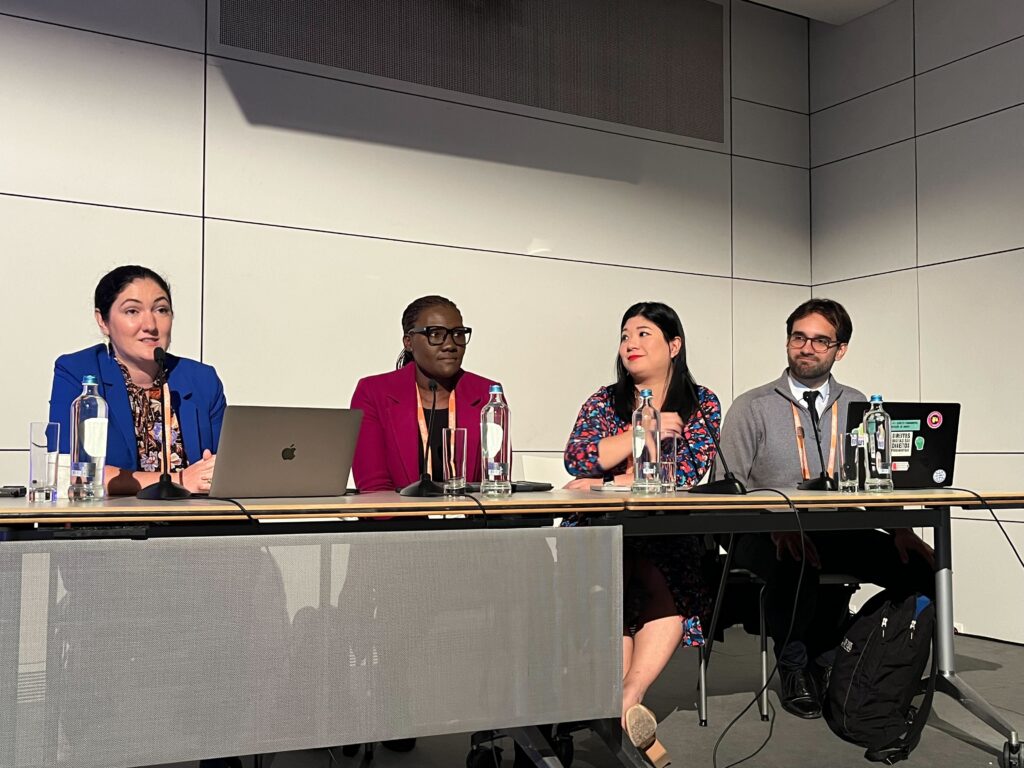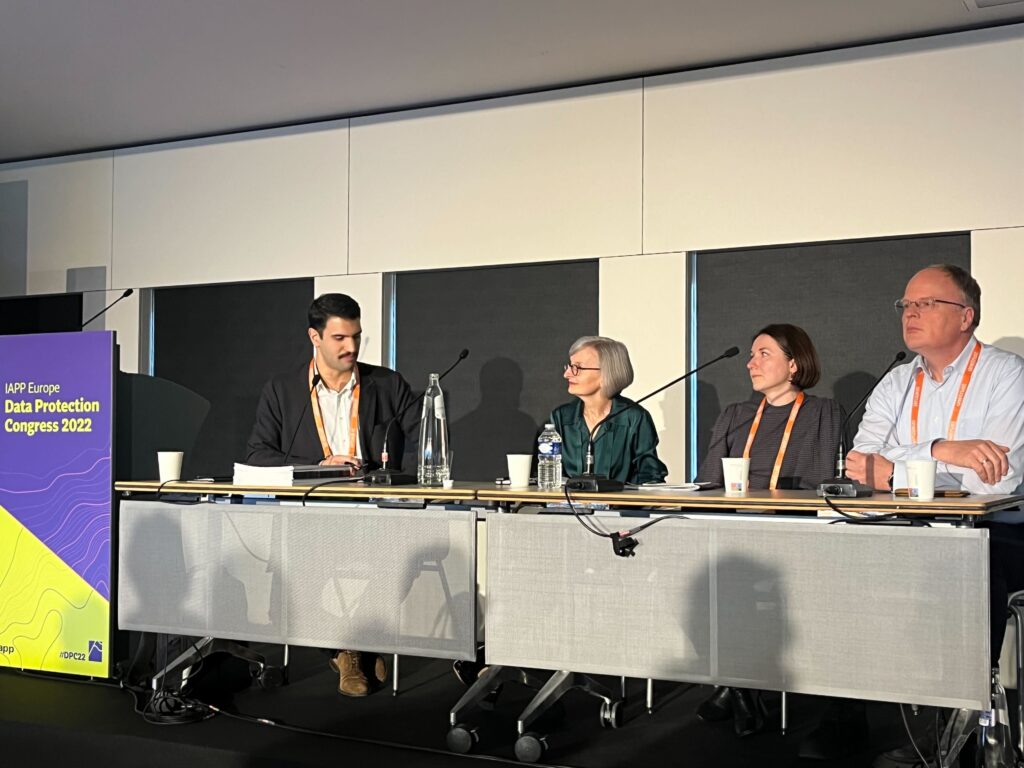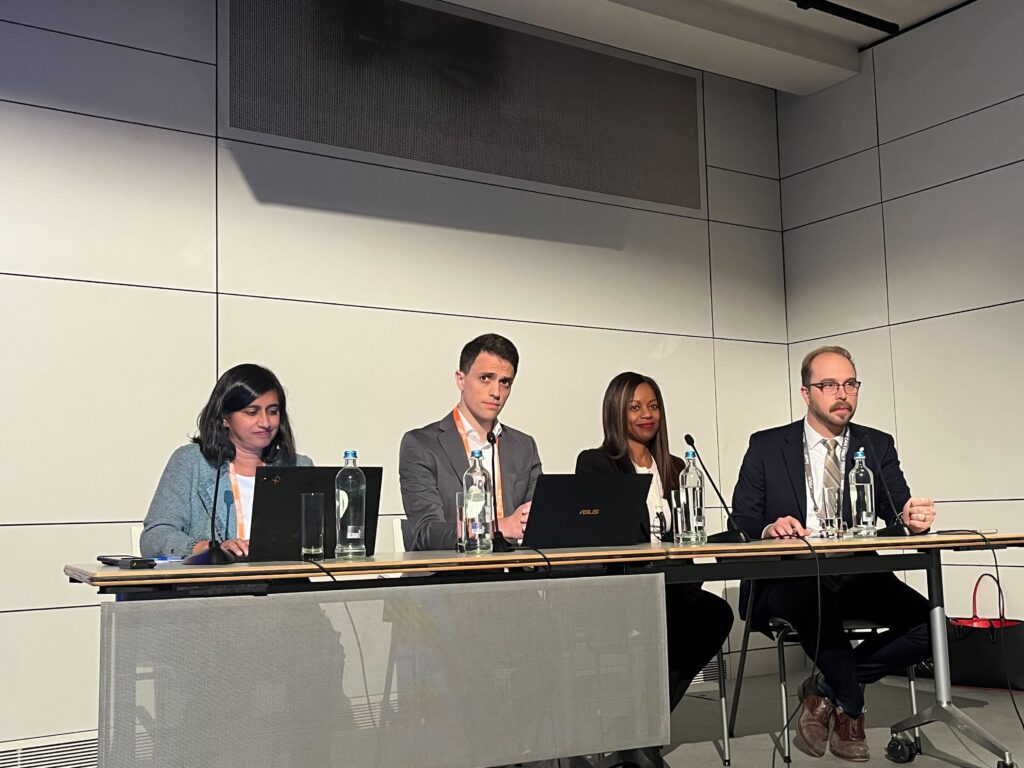FPF at IAPP’s Europe Data Protection Congress 2022: Global State of Play, Automated Decision-Making, and US Privacy Developments
Authored by Christina Michelakaki, FPF Intern for Global Policy
On November 16 and 17, 2022, the IAPP hosted the Europe Data Protection Congress 2022 – Europe’s largest annual gathering of data protection experts. During the Congress, members of the Future of Privacy Forum (FPF) team moderated and spoke at three different panels. Additionally, on November 14, FPF hosted the first Women@Privacy awards ceremony at its Brussels office, and on November 15, FPF co-hosted the sixth edition of its annual Brussels Privacy Symposium with the Vrije Universiteit Brussels (VUB)’s Brussels Privacy Hub on the issue of “Vulnerable People, Marginalization, and Data Protection” (event report forthcoming in 2023).
In the first panel for IAPP’s Europe Data Protection Congress, Global Privacy State of Play, Gabriela Zanfir-Fortuna (VP for Global Privacy, Future of Privacy Forum) moderated a conversation on key global trends in data protection and privacy regulation in jurisdictions from Latin America, Asia, and Africa. Linda Bonyo (CEO, Lawyers Hub Africa), Annabel Lee (Director, Digital Policy (APJ) and ASEAN Affairs, Amazon Web Services), and Rafael Zanatta (Director, Data Privacy Brasil Research Association) participated.
In the second panel, Automated Decision-making and Profiling: Lessons from Court and DPA Decisions, Sebastião Barros Vale (EU Privacy Counsel, Future of Privacy Forum) led a discussion on FPF’s ADM case-law report and impactful cases and relevant concepts for automated decision-making regulation under the GDPR. Ruth Boardman (Partner, Co-head, International Data Protection Practice, Bird & Bird), Simon Hania (DPO, Uber), and Gintare Pazereckaite (Legal Officer, EDPB) participated.
Finally, in the third panel, Perspectives on the Latest US Privacy Developments, Keir Lamont (Senior Counsel, Future of Privacy Forum) participated in a conversation focused on data protection developments at the federal and state level in the United States. Cobun Zweifel-Keegan (Managing Director, D.C., IAPP) moderated it, and Maneesha Mithal (Partner, Privacy and Cybersecurity, Wilson Sonsini Goodrich & Rosati) and Dominique Shelton Leipzig, (Partner, Cybersecurity & Data Privacy; Leader, Global Data Innovation & AdTech, Mayer Brown) also participated.
Below is a summary of the discussions in each of the three panels:
1. Global trends and legislative initiatives around the world
In the first panel, Global Privacy State of Play, Gabriela Zanfir-Fortuna stressed that although EU and US developments in privacy and data protection are in the spotlight, the explosion of regulatory action in other regions of the world is very interesting and deserves more attention.
Linda Bonyo touched upon the current movement in Africa where countries are adopting their own data protection laws, primarily inspired by the European model of data protection regulation, since they trust that the GDPR is a global standard and lack the resources to draft policies from scratch. Bonyo also added that the lack of resources and limited expertise are the main reasons why African countries struggle to establish independent Data Protection Authorities (DPAs). She then stressed that the Covid-19 pandemic revived discussions about a continental legal framework to address data flows. Regarding enforcement, she noted that for Africa, the approach looks rather “preventative” than “punitive.” Bonyo also underlined that it is common for big tech companies to operate outside of the continent and only have a small subsidiary in the African region, rendering local and regional regulatory action less impactful than in other regions.
Annabel Lee offered her view on the very dynamic Asia-Pacific region, noting that the latest trends, especially post-GDPR, include not only the introduction of new GDPR-like laws but also the revision of existing ones. Lee noted, however, that the GDPR is a very complex piece of legislation to “copy,” especially if a country is building its first data protection regime. She then focused on specific jurisdictions, noting that South Korea has overhauled its originally fragmented framework with a more comprehensive one and that Australia will implement a broad extraterritorial element in its revised law. Then Lee stated that when it comes to implementation and interpretation, data protection regimes in the region differ significantly, and countries try to promote harmonization by mutual recognition. With regards to enforcement, she stressed that it is common to see occasional audits and that in certain countries, such as Japan, there is a very strong culture of compliance. She also added that education can play a key role in working towards harmonized rules and enforcement. Lee offered Singapore as an example, where the Personal Data Protection Commission gives companies explanations not only on why they are in breach but also on why they are not in breach.
Rafael Zanatta explained that after years of strenuous discussions, there is an approved data protection legislation in Brazil (LGPD) that has already been in place for a couple of years. The new DPA created by the LGPD will likely ramp up its enforcement duties next year and has, so far, focused on building experimental techniques (to help incentivize associations and private actors to cooperate) and publishing guidelines, namely non-binding rules that will provide future interpretation for cases. Zanatta stressed that Brazil has been experiencing the formalization of autonomous data protection rights with supreme court rulings stating that data protection is a fundamental right different from privacy. He underscored that it will be interesting to see how the private sector applies data protection rights given their horizontal effect and the development of concepts like positive obligations and the collective dimension of rights. He explained that the extraterritorial applicability of Brazil’s law is very similar to the GDPR since companies do not need to operate in Brazil for the law to apply. He also touched upon the influence of Mercosur, a South American trade bloc, in discussions around data protection and the collective rights of the indigenous people of Bolivia in light of the processing of their biometric data. With regards to enforcement, he explained that in Brazil, it is happening primarily through the courts due to Brazil’s unique system where federal prosecutors and public defenders can file class actions.

2. Looking beyond case law on automated decision-making
In the second panel, Automated Decision-making and Profiling: Lessons from Court and DPA Decisions, Sebastião Barros Vale offered an overview of FPF’s ADM Report, noting that it contains analyses of more than 70 DPA decisions and court rulings concerning the application of Article 22 and other related GDPR provisions. He also briefly summarized the Report’s main conclusions. One of the main points he highlighted is that the GDPR covers automated decision-making (ADM) comprehensively beyond Article 22, including through the application of overarching principles like fairness and transparency, rules on lawful grounds for processing, and carrying out Data Protection Impact Assessments (DPIA).
Ruth Boardman underlined that the FPF Report reveals the areas of the law that are still “foggy” regarding ADM. Boardman also offered her view on the Portuguese DPA decision concerning a university using proctoring software to monitor students’ behavior during exams and detect fraudulent acts. The Portuguese DPA ruled that the Article 22 prohibition applied, given that the human involvement of professors in the decisions to investigate instances of fraud and invalidate exams was not meaningful. Boardman further explained that this case, along with the Italian DPA’s Foodhino case, shows that the human in the loop must have meaningful involvement in the process of making a decision for Article 22 GDPR to be inapplicable. She added that internal guidelines and training provided by the controller may not be definitive factors but can serve as strong indicators of meaningful human involvement. Regarding the concept of “legal or similarly significant effects” — another condition for the application of Article 22 GDPR – Boardman noted the link between such effects and contract law. For example, in the case of national laws transposing the e-Commerce Directive in which adding a product to a virtual basket counts as an offer to the merchant and not as a binding contract, no legal effects are triggered. She also added that meaningful information about the logic behind ADM should include the consequences that data subjects can suffer and referred to an enforcement notice from the UK’s Information Commissioner Office concerning the creation of profiles for direct marketing purposes.
Simon Hania argued that the FPF Report showed the robustness of the EDPB guidelines on ADM and that ADM triggers GDPR provisions that are relevant to fairness and transparency. With regards to the “human in the loop” concept, Hania claimed that it is important to involve multiple humans and ensure that they are properly trained to avoid biased decisions. Then he elaborated on a case concerning Uber’s algorithms that match drivers with clients, where Uber drivers requested access to data to assess whether the matching process was fair. For the Amsterdam District Court, the drivers did not demonstrate how the matching process could have legal or similarly significant effects on them, which meant that drivers did not have enhanced access rights that would only apply if ADM covered by Article 22 GDPR was at stake. However, when ruling on an algorithm used by another ride-hailing company (Ola) to calculate fare deductions based on drivers’ performance, the same Court found that the ADM at issue had significant effects on drivers. For Hania, a closer inspection of the two cases reveals that both ADM schemes affect drivers’ ability to earn or lose remuneration, which highlights the importance of financial impacts when assessing the effects of ADM as per Article 22. He also touched on a decision from the Austrian DPA concerning a company that scored individuals on the likelihood they would belong to certain demographic groups, as the DPA mandated the company to inform individuals about how it calculated their individual scores. For Hania, the case shows that controllers need to explain the reasons behind their automated decisions – regardless of whether they are covered by Article 22 GDPR or not – to comply with the fairness and transparency principles of Article 5 GDPR.
Gintare Pazereckaite noted that the FPF Report is particularly helpful in understanding inconsistencies in how DPAs apply Article 22 GDPR. She then stressed that the interpretation of “solely automated processing” should be done in light of protecting and safeguarding data subjects’ fundamental rights. Pazereckaite also referred to the criteria set out by the EDPB guidelines that clarify the concept of the “legal and similarly significant effects.” She added that data protection rules such as accountability and data protection by design play an important role in allowing data subjects to understand how ADM works and what consequences it may bring up. Lastly, Pazereckaite commented on Article 5 of the proposed AI Act – which contains a list of prohibited AI practices – and its importance when an algorithm does not trigger Article 22 GDPR.

3. ADPPA and regional laws re-shaping US data protection regime
In the last panel, Perspectives on the Latest US Privacy Developments, Keir Lamont offered an overview of recent US Congressional efforts to enact the American Data Privacy and Protection Act (ADPPA) and outstanding areas of disagreement. For him, the bill would introduce stronger rights and protections than those set forth in existing state-level laws; including a broad scope; strong data minimization provisions; limitations on advertising practices; enhanced privacy-by-design requirements; algorithmic impact assessments; and a private right of action. In contrast, existing state laws typically adhere to the outdated opt-in/opt-out paradigm for establishing individual privacy rights.
Maneesha Mithal explained that in the absence of comprehensive federal privacy legislation, the Federal Trade Commission (FTC) has largely taken on the role of DPA by virtue of having jurisdiction over a broad range of sectors in the economy and acting both as an enforcement and rulemaking agency. Mithal explained that the FTC enforces four existing privacy laws in the US and can also take action against both unfair and deceptive trade practices. For example, the FTC can enforce against any statement (irrespective of whether it is in a privacy policy or the context of user interfaces), material omissions (for example, the FTC has concluded that a company did not inform its clients that it was collecting second by second television data and was further sharing it), and unfair practices in the data security area. Mithal pointed out that since the FTC does not have the authority to seek civil penalties for first-time violations, it is trying to introduce additional deterrents by naming individuals (for example, in the case of an alcohol provider, the FTC named the CEO for failing to prioritize security) and is using its power to obtain injunctive relief. For example, in a case where a company was unlawfully using facial recognition systems, the FTC ordered the company to delete any models or algorithms that were used, and thus FTC applied the fruit to the poisonous tree theory. Mithal also noted that although the FTC has historically not been active as a rulemaking authority due to procedural issues along with the lack of resources and time considerations, it is initiating a major rulemaking involving “Commercial Surveillance and Lax Data Security Practices.”
Finally, Dominique Shelton Leipzig offered remarks on state-level legislation focusing on the California Consumer Privacy Act (CCPA) as amended by the California Privacy Rights Act (CPRA), adding that Colorado, Connecticut, Utah, and Virginia have similar laws. She elaborated on the CPRA’s contractual language, comparing California’s categorization of “Businesses,” “Contractors,” “Third Parties,” and “Service Providers” to the GDPR’s distinction between controllers and processors. Shelton Leipzig also explained that the CPRA introduced a highly disruptive model for the ad tech industry since consumers can opt out of both the sale of data, as well as the sharing of data. The CPRA also created a new independent rulemaking and enforcement Agency, the first in the US, focusing only on data protection and privacy. Finally, she addressed the recently enacted California Age-Appropriate Design Code Act, which focuses on the design of internet tools, and stressed that companies are struggling to implement it.

Further reading:
- FPF’s comments to the Federal Trade Commission’s Commercial Surveillance ANPR: “FPF Urges Federal Trade Commission to Craft Practical Privacy Rules”, November 2022
- FPF’s policy brief: “An Analysis of the California Age-Appropriate Design Code,” October 2022
- FPF’s report: “Automated Decision-Making Under the GDPR: Practical Cases from Courts and Data Protection Authorities,” May 2022
